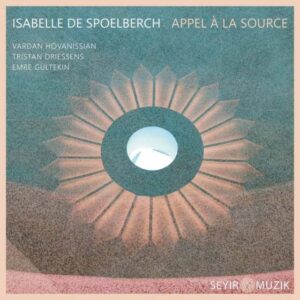
Appel À La Source is de titel van het debuutalbum van de Waalse harpiste Isabelle de Spoelberch. In een fraai exposé horen we haar, begeleid door een trio van duduk (Armeens dubbelriet-instrument), ûd (Arabische luit) en saz/baglama (Turkse langhalsluiten).
English version below
…maar dat trio wordt nog uitgebreid met negen gastmusici waarmee Isabelle de Spoelberch een hemelsbreed muzikaal spectrum creëert. In elk stuk staat de harp centraal, d.w.z. soms ook de kantele (de Finse citer). De composities zijn overwegend langzaam, mijmerend en peinzend van karakter. Open en transparante arrangementen zorgen voor een reverie die je meeneemt over de zeeën tot ver achter de bergen. De kern van muziek is min of meer folk georiënteerd, maar krijgt door het gebruik van o.a. de Armeense duduk, gespeeld door Vardan Hovanissian, Turkse snaarinstrumenten door Emre Gültekin en de Arabische luit van Tristan Driessens ook een tintelend Oriëntaals randje. Het dubbel-album Appel À La Source wordt gelardeerd met Solo Harp Improvisation I t/m IV en de adembenemend mooie Harp and Duduk Dialogue I en II (en Lève les deux). Deze laatste twee zijn composities waarin Hovanissian de lucht liefdevol laat zinderen met zijn dudukspel, smaakvol begeleid door de harp. Op het 2de album staan naast instrumentale werken ook enkele vocale stukken. Bijzonder daarbij zijn de Afrikaanse zang van Moussa Niang in Pière pour l’Eau en de Indiase vocalen van Malabika Brahma in Dilki doya. Hierdoor krijgt de muziek een nieuw en onverwacht timbre. Wie de tijd neemt om Appel À La Source (Oproep aan de bron) met rust en aandacht te beluisteren, komt terecht op een serene en muzikale wereldreis.
English version
Appel À La Source is the title of the debut album of the Belgium harpist Isabelle de Spoelberch. In a beautiful exposé we hear her music, accompanied by a trio of duduk (Armenian double reed instrument), ûd (Arabic lute) and saz/baglama (Turkish long-necked lutes).
…but this trio is expanded with nine guest musicians with whom Isabelle de Spoelberch creates a heavenly wide musical range. In each piece the harp is central, i.e. sometimes also the kantele (the Finnish zither). The compositions are predominantly slow, musing and pensive in character. Open and transparent arrangements provide a reverie that takes you far across the sea and over the mountains. The core of the music is more or less folk oriented. By the use of the Armenian duduk, played by Vardan Hovanissian, Turkish stringed instruments by Emre Gültekin and the Arabic lute player Tristan Driessens the music gets a tingling Oriental edge. The double album Appel À La Source is interspersed with Solo Harp Improvisation I to IV and the breathtakingly beautiful Harp and Duduk Dialogue I and II (and Lève les deux). These last two are compositions in which Hovanissian makes the air lovingly shimmer with his duduk, excellent accompanied by the harp. In addition to instrumental works, the 2nd album also contains a few vocal pieces. Special are the African vocals of Moussa Niang in Pière pour l’Eau and the Indian voice of Malabika Brahma in Dilki doya. This gives the music a new and unexpected timbre. If you take the time to listen to Appel À La Source (Call to the source) with calm and attentiveness, you end up on a serene and musical world tour.
- Isabelle de Spoelberch: Appel À La Source (Seyir Muzik / Xango)
© Mattie Poels.

Geen reacties